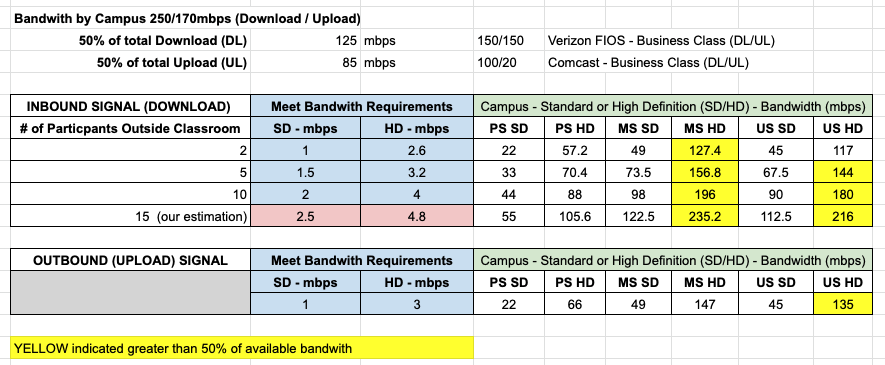There is a lot of talk about what school is going to look like in September and a lot of questions that have come with it.

Will we open online? What will our schedule look like? Will we have some kids or teachers in the building and some at home? Blended? Hybrid? Synchronous? Asynchronous? The questions go on and on…
One clear thing is that we will be using some form of technology to connect people that are in one place to those in another. With this, there are many hardware pieces to consider and how they will fit a school’s unique learning plan.
What all of these technologies will have in common is they will all need a platform to run on and bandwidth to make it all connect.
You may be using ZOOM, Google Meet, WebEx, or Teams… whatever it is you use, there are bandwidth requirements for each of these.
As we are all doing remote learning from home, the bandwidth requirements may not be all that noticeable. You may see a slow down while someone is working, and someone else is streaming a movie, on YouTube, playing Fortnite. Still, nothing like you will know when you are in school and have multiple classrooms all trying to connect to their own video stream for two-way communications.
Before you get started on all of these plans, it will be essential to get a better understanding of if you’re ready for these bandwidth requirements, and there are a few things to consider to get started.
- What conferencing service are you using? Each should provide the minimum bandwidth requirements somewhere on their website.
- How much bandwidth do you have? If you have multiple campuses, is the bandwidth shared, or does each campus have its own connection(s)?
- Are you able to prioritize traffic on your network?
- How many teaching spaces do you have in your school or on your campuses?
If you have these answers, you can start to take a look and understand what you will be able to support.
At my school, the answers are:
- We use Google Meet for our conferencing and remote learning. Google provides the minimum requirements on their web site here: https://support.google.com/meethardware/answer/4541234?hl=en. ZOOM Users: https://support.zoom.us/hc/en-us/articles/201362023-System-requirements-for-Windows-macOS-and-Linux
- We have three campuses, and each campus has its own Internet connections. Each has two links one from FIOS providing download and upload speeds of 150/150mbps and the other from Comcast, providing 100/20mbps. Each is business-class service, which includes service level agreement (SLA) with guaranteed response times and network monitoring that will help in the event of an outage.
- We use a network appliance to provide quality-of-service (QoS) for the prioritization of certain network traffic and the aggregation and load-balancing of traffic.
- There is 116 total teaching space across each of our three campuses: 22 at our Primary School, 49 at our Middle School, and 45 at our Upper School.
With these questions answered, you can drop these numbers into a spreadsheet with the service requirements for your conferencing platform and see where you stand. The highlighted areas are those instances where the bandwidth needs for Meet exceeded 50% of our total bandwidth.

These numbers represent a worst-case scenario where every classroom is in use and streaming a Google Meet. While this may seem unlikely, you should consider social distancing guidelines and those classrooms may be needed that would otherwise be empty.
Is the exercise perfect and will it tell you all you need to know? Probably not, but it will provide you a starting point. Taking a more in-depth look at your infrastructure would be highly recommended and is something you should discuss with your staff, network engineer, or consultant.


